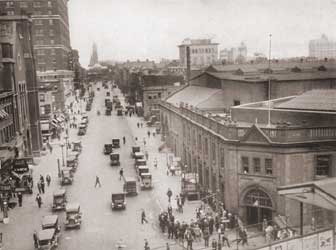
Page 28

Permanent inspection sheds were provided at Morris Park, Dunton and Rockaway Park, though the one at the latter place was afterward abandoned to the use of trolley cars.
President Baldwin died before the completion of the first great electrification. He did not live to witness the consummation of the great idea which he had conceived. To quote from the words of the Board of Directors of the Long Island Railroad Company: "The plans for the greater improvements recently begun--for closer connections with the great trunk-line systems through the medium of tunnels, and the betterment of local traffic conditions through the electrification of a portion of the Company's line--all bear the imprint of his ability, and their consummation was something to which he looked forward with prophetic vision and delight."
In January, 1905, Mr. William F. Potter, the Vice-President, was elected President. He was soon stricken and died. In April, 1905, Mr. Ralph Peters was elected President of The Long Island Railroad Company, a position which he held until his death in October, 1923.
While to Mr. Baldwin and Mr. Potter, who were associated in this work from 1897 to 1905, is due the credit of starting this electrification project which has revolutionized modern railroading, to Ralph Peters, who succeeded them, is due the credit of carrying out not only these projects, but many others. Its twentieth President, Mr. Peters, held that office longer than any of his predecessors.
Richard Peters, his father, was one of the pioneer railroad builders and developers of the South, who started his career on the Camden and Amboy and Pennsylvania Railroads with J. Edgar Thomson. Ralph Peters entered railroad service in 1872, and had completed fifty-one years of untiring efforts in railroad work when called to his final reward. He came to the Long Island in 1905, at a time when he was General Superintendent of the Southwest System of the Pennsylvania Lines west of Pittsburgh. From June, 1918, to March, 1920, he was selected to act as Federal Manager of the Long Island System by the Director-General of Railroads. His record during the war period is full of most unusual and difficult operating tasks, well performed for the War and Navy Departments.

The Flatbush Avenue station is still the Brooklyn terminal of the Atlantic Branch, but this building, modest compared to the New York terminal, is, like old Pennsylvania Staton, long gone. Its replacement is yet to be built. Larger image (45.0K)
The cars carried one trailer truck and one motor truck, with two two-hundred-horsepower No. 113 Westinghouse motors. The cars were fifty-one feet long, nine and one-half feet wide, of all-steel fireproof construction. The cars and trucks were designed by George Gibbs, who also designed the New York Subway cars. The Long Island Railroad shares with the New York Subway the honor of operating the first fireproof cars. They weigh 83,000 pounds, and reach a speed of fifty-five miles per hour.
In November, 1904, the first order for cars was placed. One hundred and thirty-three were obtained. They were known as MP-41 class. Five wooden baggage cars, conforming to M. C. B. standards, were also bought. They were fifty-two feet long, known as MB-45 class. The cars were built by the American Car and Foundry Company, and the trucks by the Baldwin Locomotive Works. They were equipped with Westinghouse pneumatic multiple-unit control. The cars were assembled and equipped at the shops between Locust Avenue and Springfield.
Updated
©2001 The Composing Stack Inc. All right reserved